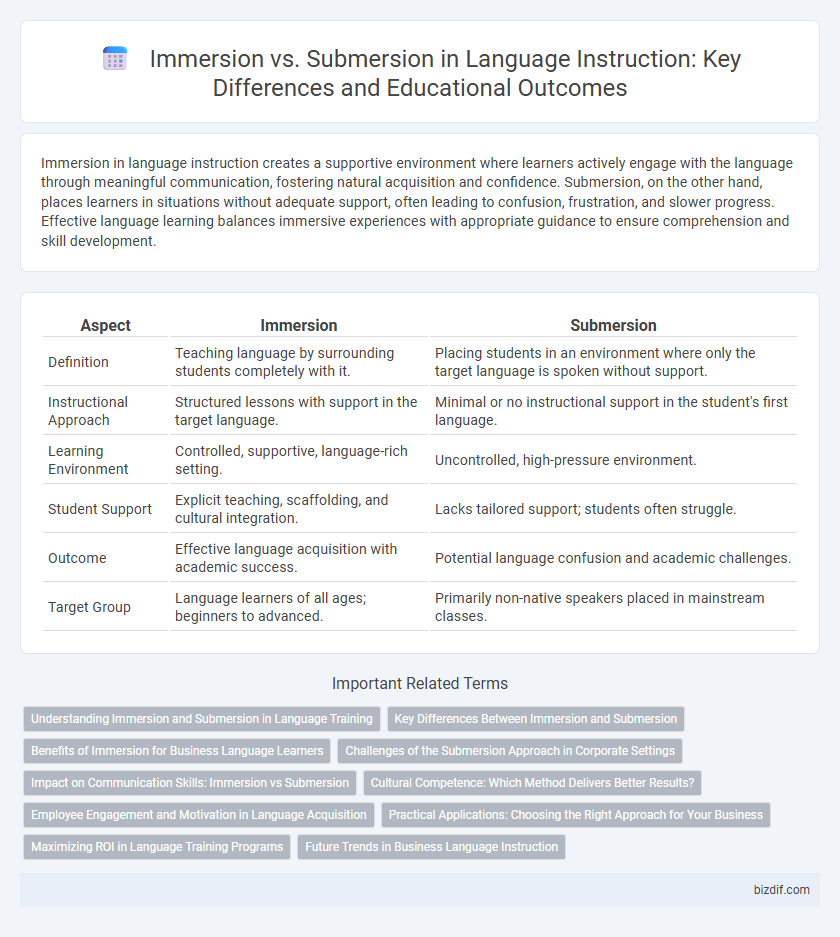Immersion in language instruction creates a supportive environment where learners actively engage with the language through meaningful communication, fostering natural acquisition and confidence. Submersion, on the other hand, places learners in situations without adequate support, often leading to confusion, frustration, and slower progress. Effective language learning balances immersive experiences with appropriate guidance to ensure comprehension and skill development.
Table of Comparison
| Aspect | Immersion | Submersion |
|---|---|---|
| Definition | Teaching language by surrounding students completely with it. | Placing students in an environment where only the target language is spoken without support. |
| Instructional Approach | Structured lessons with support in the target language. | Minimal or no instructional support in the student's first language. |
| Learning Environment | Controlled, supportive, language-rich setting. | Uncontrolled, high-pressure environment. |
| Student Support | Explicit teaching, scaffolding, and cultural integration. | Lacks tailored support; students often struggle. |
| Outcome | Effective language acquisition with academic success. | Potential language confusion and academic challenges. |
| Target Group | Language learners of all ages; beginners to advanced. | Primarily non-native speakers placed in mainstream classes. |
Understanding Immersion and Submersion in Language Training
Immersion in language training involves surrounding learners with the target language in natural contexts, promoting intuitive understanding and practical usage, while submersion exposes learners to the language without sufficient support, often leading to confusion and limited comprehension. Effective immersion programs integrate cultural elements and interactive communication to enhance retention and fluency. Submersion lacks structured guidance, making it challenging for learners to progress despite high exposure to the new language.
Key Differences Between Immersion and Submersion
Immersion involves surrounding learners with the target language in meaningful contexts to promote natural acquisition, while submersion places students in environments where only the target language is used without systematic support. Immersion programs emphasize comprehensible input and gradual skill development, whereas submersion often leads to confusion and language barriers due to lack of scaffolding. Key differences include instructional design, learner support, and outcomes on language proficiency and confidence.
Benefits of Immersion for Business Language Learners
Immersion programs accelerate language acquisition by surrounding business learners with real-world vocabulary and authentic communication scenarios, enhancing fluency and comprehension. This method improves cultural understanding and context-specific language use, crucial for effective negotiation and international collaboration. Immersion also fosters confidence and adaptability, enabling professionals to navigate diverse business environments smoothly.
Challenges of the Submersion Approach in Corporate Settings
The submersion approach in corporate language instruction often leads to significant challenges, including employee frustration and decreased productivity due to insufficient language support. Learners may struggle with comprehension gaps that hinder effective communication and collaboration within multinational teams. This lack of tailored assistance frequently results in longer adaptation periods and potential disengagement from professional development opportunities.
Impact on Communication Skills: Immersion vs Submersion
Immersion language instruction fosters advanced communication skills by encouraging active participation and authentic use of the target language in diverse contexts, enhancing fluency and cultural understanding. Submersion often leads to limited communication development due to learners being placed in environments without adequate linguistic support, causing frustration and decreased language confidence. Research shows immersion students outperform submersion peers in speaking, listening, and pragmatic language abilities essential for real-world communication.
Cultural Competence: Which Method Delivers Better Results?
Immersion programs significantly enhance cultural competence by surrounding learners with authentic language use and cultural contexts, fostering deeper understanding and practical communication skills. Submersion, often characterized by placing learners in mainstream environments without tailored support, tends to hinder cultural assimilation and language acquisition due to increased stress and confusion. Research indicates that immersion strategies produce more effective language proficiency and cultural adaptability compared to submersion approaches.
Employee Engagement and Motivation in Language Acquisition
Immersion language instruction significantly boosts employee engagement by creating a natural learning environment that fosters active participation and contextual understanding. Submersion often leads to decreased motivation as employees struggle without adequate support, resulting in frustration and disengagement. Effective immersion programs enhance motivation through immersive cultural experiences and continuous feedback, accelerating language acquisition in the workplace.
Practical Applications: Choosing the Right Approach for Your Business
Immersion language instruction engages employees by surrounding them entirely in the target language, promoting natural acquisition and fluency essential for global business interactions. Submersion places learners in a target-language environment with minimal support, which may cause stress but accelerates adaptation and problem-solving skills critical in high-pressure international settings. Businesses should evaluate workforce language proficiency and operational goals to select immersion for foundational skill-building or submersion for rapid, intensive language adaptation.
Maximizing ROI in Language Training Programs
Immersion language training programs offer superior ROI by fully engaging learners in practical communication, accelerating fluency through contextual learning and cultural exposure. Submersion techniques, while cost-effective, often lead to learner frustration and attrition due to insufficient scaffolding and lack of targeted support. Prioritizing immersive methods with structured instructional frameworks maximizes proficiency gains and long-term retention, optimizing training investments.
Future Trends in Business Language Instruction
Immersion techniques in business language instruction enhance communicative competence by integrating real-world contexts and technology-driven simulations, fostering practical language use and cultural understanding. Future trends indicate a shift towards AI-powered personalized learning environments that adapt to individual learner needs and industry-specific vocabulary. Submersion methods, while less favored, remain relevant for fostering rapid adaptation in high-pressure business settings, supporting resilience and contextual problem-solving skills.
Immersion vs Submersion Infographic

 bizdif.com
bizdif.com